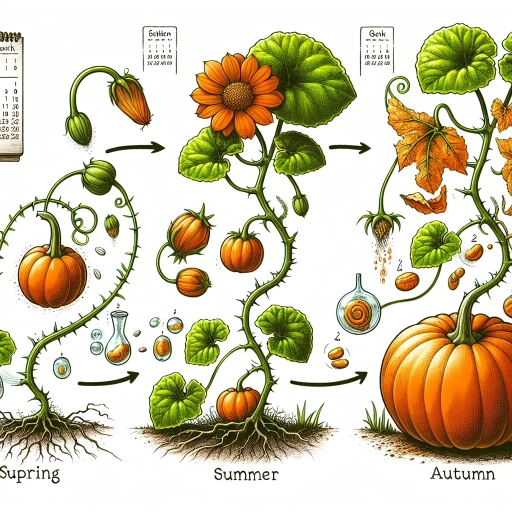How Long Do Pumpkins Last

Understanding the Life Cycle of a Pumpkin
The Growth Process of a Pumpkin
Understanding the life span of a pumpkin begins from the moment it's planted. The pumpkin's life cycle is simple yet fascinating. The whole process starts with planting the pumpkin seeds in a warm, fertile soil, where germination kicks off. This process typically takes between 5 - 10 days. Once the seed sprouts, it develops a tiny root which grows deeper into the soil, gathering nutrients and moisture necessary for the plant's growth. The sprout also develops leaves which will start photosynthesis, converting sunlight into food for the plant.
The Maturation of a Pumpkin
Once the pumpkin plant has established itself after germination, it starts flowering. Pumpkin plants are monoecious, which means they grow separate male and female flowers on the same plant. The flowers are typically bright yellow and are a favourite amongst bees. The female flowers produce small green balls at the base which are baby pumpkins. And, if these flowers get fertilized by bees carrying pollen from the male flowers, the baby pumpkins will grow into mature pumpkins. The maturation process can take between 90 - 120 days depending on the pumpkin variety and growing conditions.
The Harvesting and Post-Harvest Life of a Pumpkin
The signal for harvesting pumpkins is usually a change in colour from green to orange. Moreover, the pumpkin's skin becomes hard and the vine starts to wither, which signifies the readiness of the pumpkin for harvesting. Post harvest, pumpkins can last anywhere from 2 weeks to 6 months depending on the variety and how well it's stored. The conditions that the pumpkin is kept in post-harvest greatly influence its shelf life. For instance, a freshly harvested pumpkin kept in a cool, dry place can last several months, whereas a carved pumpkin used for decorations might last only a few days before it starts to rot.
Pumpkin Longevity–Various Factors Involved
Impact of Storage Conditions on Pumpkin's Shelf Life
The storage conditions of pumpkins greatly influence how long they last. Pumpkins prefer cool, dark, dry places for storage with temperatures between 50 – 55°F. Higher temperatures can cause pumpkins to rot faster and lower temperatures can cause the pumpkin's flesh to become soft and inedible. Furthermore, pumpkins should be stored off the ground to avoid moisture build-up which could lead to rot. The storage surface should also be clean, preventing any potential infection from rot-causing bacteria or fungus. Finally, the storage room should be well-ventilated to prevent any build-up of humidity which might fast-track the rotting process.
Role of Pumpkin Variety
Not all pumpkins are created equal. Some varieties of pumpkins naturally last longer than others. For instance, the field pumpkins, also known as jack-o'-lantern pumpkins, generally have a shorter shelf life compared to sugar or pie pumpkins. The difference lies both in the sugar content and the thickness of their skin. More sugar and thicker skin usually make pumpkins last longer. So, when choosing pumpkins, the variety chosen should align with the intended usage and required shelf life.
The Impact of Handling and Usage
The way a pumpkin is handled after it's harvested can also impact its shelf life. Pumpkins should always be handled with care to prevent any nicks, cuts or bruises which could expose the pumpkin's flesh, making it susceptible to rot-causing bacteria and fungi. In terms of usage, carved pumpkins will obviously not last as long as their intact counterparts. Once a pumpkin is carved, it's exposed to the elements which fastens the degrading process, usually taking a few days to a week for the carved pumpkin to become unusable.
Preserving Pumpkins for Long-Term Storage
Curing Pumpkins to Extend their Shelf Life
Pumpkins can be cured to extend their shelf life. The process of curing involves keeping the harvested pumpkins in a warm (approximately 80 - 85°F), well-ventilated area for about a week or two. This process helps in hardening the pumpkin's skin, heals any cuts or nicks and reduces the fruit's overall moisture content. The end result is a pumpkin that can be stored for a longer period without degradation.
Preserving Pumpkins through Freezing
Another well-known method to extend a pumpkin's shelf life is through freezing. The pumpkin must first be cut into appropriate sizes, blanched, and then cooled before it's packaged and placed in the freezer. Freezing slows down the activity of enzymes and microorganisms that cause food spoilage, allowing the pumpkin to be stored for an extended period.
Canning and Pickling - Traditional Ways of Pumpkin Preservation
Canning and pickling are traditional methods of preserving pumpkins. In canning, the pumpkin is preserved in a sugar syrup within an airtight jar, which is then sealed and heated to kill bacteria, yeast and enzymes. On the other hand, pickling involves storing the pumpkin in vinegar or a similar solution to create an acidic environment which inhibits the action of bacteria, extending the pumpkin's life. Both methods give unique flavours to the pumpkin and can preserve it for several months to years.